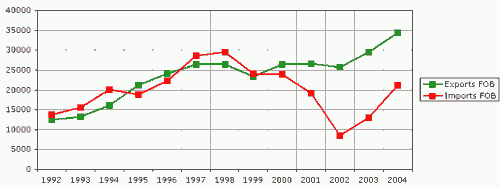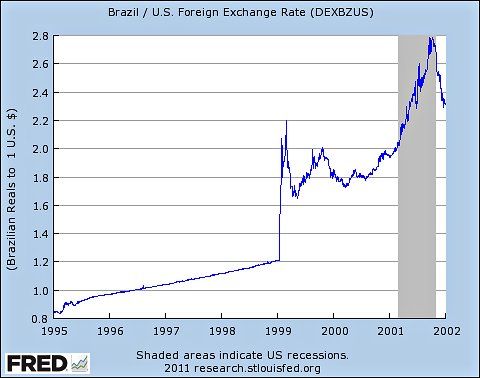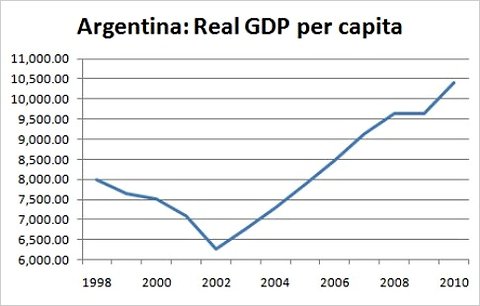Readers Question: With talk of a Greek exit from the Euro, the situation is almost always compared to Argentina in the 1980s and 90s. Can you explain what happened there and how it was resolved.
In the 1980s, Argentina built up substantial debt and also suffered from periods of very high inflation. To stabilise inflation, Argentina set a peg of the Argentina Peso against the dollar – the peg was one Peso to one dollar (this was enshrined in law).
The aim of this fixed exchange rate was to give people greater confidence in the Argentinian currency after periods of inflation.
- The fixed exchange rate meant that inflation was stabilised and encouraged capital flows into Argentina. These capital flows led to a rise in wages and living standards
- It also made imports cheaper, so the value of imports increased,
- Exports became less competitive, leading to lower demand for exports.
- This fall in exports and rise in imports lead to a current account deficit which was initially financed by these international capital flows.
- However, the over-valuation of the currency contributed to a fall in domestic demand, and from 1998, Argentina experienced fall in GDP.
- Also from 2001, international capital flows to Argentina dried up as investors were worried about the state of the global economy and the state of Argentina finances.
In particular, Argentina was adversely affected when the dollar rose against the Brazilian Real in 1999. This meant that the Argentina currency experienced a strong appreciation against its main trading partner – Brazil. This appreciation led to rapid fall in exports.
This appreciation in the Argentina currency was a key factor in pushing Argentina economy into a deep recession. Domestic demand fell. Unemployment rose to a socially crippling level of over 15%.
Government Debt
During 1999-2002, the Argentina government debt became unmanageable. This was because:
- Legacy of debt from 1980s
- Poor tax collection and corruption
- Rise in government spending
- Fall in tax revenues from recession.
International investors lost confidence in Argentinian bonds and interest rates rose to over 30%. Argentina relied on loans from the IMF to meet its shortfall.
Austerity
In response to the debt crisis, the Argentinian government implemented many austerity measures, such as spending cuts and wage cuts to try and meet IMF deficit reduction targets.
The austerity measures led to a bigger fall in GDP, but did not solve the debt crisis because the austerity measures created even lower economic growth.
In 2001, Argentina was in real crisis. The economy was in meltdown, there were protests on the streets and it couldn’t meet its external debt commitment. It was at this point Argentina defaulted on its external debts and left the currency peg.
Leaving the Fixed Exchange Rate
Argentina left the fixed exchange rate and stopped trying to keep the currency pegged against the dollar. The government also tried to prevent capital outflows by freezing bank accounts for 12 months. Leaving the currency peg, led to a huge devaluation in the Argentinian currency.
From 1 Argentina Peso = 1 US Dollar. By 2002, the currency fell to 4 Peso to 1 Dollar. Inflation was running at 80%
This led to imported inflation and a large reduction in living standards.

Benefits of Devaluation in Argentina Peso
When Argentina left the fixed exchange rate, it was very grim situation. Capital fled from Argentina and consumer spending fell amidst uncertainty. However, the devaluation made Argentina exports much more competitive and imports uncompetitive. This led to a big increase in export demand (helped by rise in price of soya).
Also, the devaluation forced people to buy less imports and more domestically produced goods which was good for Argentinian industry.
Since the devaluation and debt default, Argentina has posted impressive rates of economic growth. This suggests that despite defaulting on debt and leaving the ‘security’ of a fixed exchange rate the economy can recover.
Costs of Devaluation
- There was a big fall in living standards from devaluation.
- Argentina has had inflation since devaluation (official figures 9% in 2011. Congressional estimate of 22%)
- Most savings were lost
- Argentina has a bad reputation for borrowing (though it hasn’t been permanently locked out of bond markets)
However, the main thing is that the economy could recover and unemployment fell from the critical peaks of the early 2000s
Similarities Between Greece and Argentina
- Both generated large government debt due to poor tax collection, overspending, and impact of recession.
- To deal with budget deficit, both tried austerity measures. Austerity measures led to bigger falls in GDP and failed to solve the debt problem.
- Both countries suffered from a lack of competitiveness in a fixed exchange rate. This lack of competitiveness contributed to serious fall in GDP and high unemployment.
Can Greece Emulate Argentina – Default and Leave the Euro?
- The Argentina example shows that defaulting on debt and enduring a massive devaluation can enable long term recovery.
- If Greece leaves Euro, it will see a massive devaluation in its currency making imports more expensive and exports cheaper.
Is Greece Different to Argentina?
- Some argue that Greece doesn’t have the same export industries as Argentina. Therefore, will not benefit as much from a devaluation. Though others disagree saying that there will be a significant boost to domestic demand. The current account deficit of 10% suggests Greece is suffering from over-valuation.
- Argentina crisis occurred in 2002 and could benefit from economic growth in world economy and near neighbours like Brazil. Greece may face it’s main trading partners suffering similar crisis, therefore it will be much harder.
- On the other hand, is is worth Greece persevering with its failed policy of membership of the Euro and Austerity which has done nothing to solve fiscal and economic crisis.
- There wasn’t just a devaluation. The government also made great efforts to improve tax collection and control government spending.
Related
External links
- Argentina example to Greece and Spain at Slate
- Don’t cry for Argentina at Krugman blog NY Times
- Argentina CIA factbook



1 thought on “Argentina crisis and recovery”
Comments are closed.